This set of Analog Circuits Multiple Choice Questions & Answers (MCQs) focuses on “Effects of Feedback”.
1. What is the reverse transmission factor?
a) Ratio of output by input signal
b) Ratio of feedback by input signal
c) Ration of feedback by output signal
d) Ratio of input by feedback signal
View Answer
Explanation: In feedback systems, the feedback signal is in proportion with the output signal.
XF ∝ XO
XF = βXO, where β is the feedback factor or reverse transmission factor.
2. Return ratio for a circuit is 220. What is the amount of feedback, correct up to 2 decimal places?
a) 2.34 dB
b) – 46.84 dB
c) – 46.88 dB
d) 46.88 dB
View Answer
Explanation: Return ratio is Aβ, where β=feedback factor, and A=open loop gain.
Amount of feedback is AF/A = 1 + Aβ
In decibels, amount of feedback = -20log10(1+Aβ) = -20log10(221) = -46.88 decibels.
3. Consider the given diagram. Loop gain is 19. Consider closed loop gain is 50. Find the output without any feedback when input is 5.

a) 1000
b) 500
c) 5000
d) 50000
View Answer
Explanation: Feedback factor, β=10.
AF = A/(1+Aβ) = 50
A = 20*50 = 1000
Output is thus 5000.
4. Consider an open loop circuit with lower cutoff frequency 5kHz and upper cutoff frequency 20kHz. If negative feedback is applied to the same, choose correct option stating the new cutoff frequencies.
a) Lower cutoff = 5kHz, Upper cutoff = 20kHz
b) Lower cutoff = 2kHz, Upper cutoff = 18kHz
c) Lower cutoff = 2kHz, Upper cutoff = 25kHz
d) Lower cutoff = 10kHz, Upper cutoff = 25kHz
View Answer
Explanation: Negative feedback decreases lower cutoff frequencies and increases the higher cutoff frequency.
fHF = fH(1+Aβ)
fLF = fL/(1+Aβ)
Total bandwidth is thus increased.
5. Find the relative change in gain with negative feedback given that return ratio is 24, and feedback factor is 3, when the change in open loop gain is 2.
a) 1
b) 1.6
c) 0.1
d) 0.01
View Answer
Explanation: AF = A/(1+Aβ)
Aβ = 24
A = 8
Relative change in gain = dAF/AF = dA/A(1+Aβ)
dAF/AF = 2/8*25 = 0.01.
6. Relative change of gain of feedback amplifier is 0.05. Also, loop gain is 9. Find desensitivity?
a) 50
b) 10
c) 20
d) 1/9
View Answer
Explanation: We can simply use the ratio of 0.1 to find the answer.
Loop gain Aβ = 9
1+Aβ = 10
Desensitivity = 1/S = 1+Aβ = 10.
7. Circuit P has desensitivity 20, circuit Q has sensitivity 0.1 and circuit R has desensitivity 40. Which of the following is more stable in gain?
a) Circuit P
b) Circuit Q
c) Circuit R
d) All circuits are equally stable in gain
View Answer
Explanation: Greater desensitivity indicates better stability in gain. More desensitivity means gain becomes smaller, but stable.
For circuit Q, desensitivity = 1/S = 10
Circuit R has higher desensitivity, hence most stable.
8. Consider the open loop response. An unknown feedback is applied. Choose the correct output of the new system from the following.
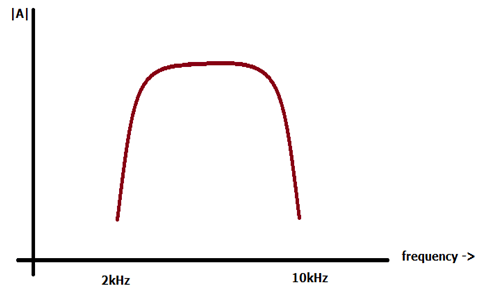
a) Output response of Increased frequency distortion
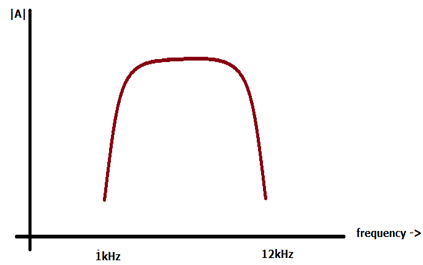
b) Output response of Decreased frequency distortion
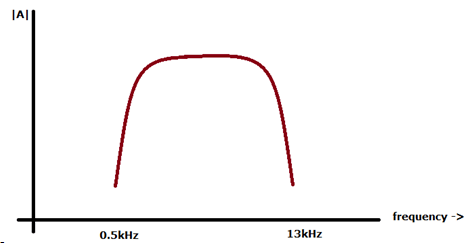
c) Output response of Decreased frequency distortion
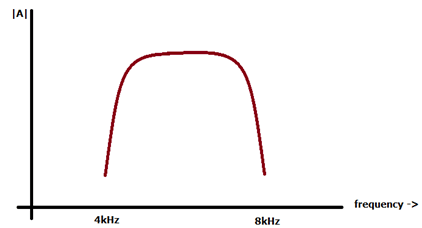
d) Output response of No change in frequency distortion.
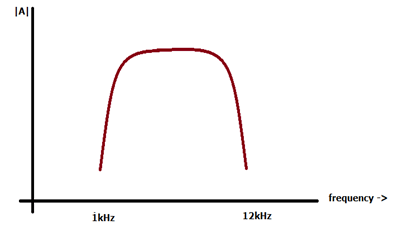
View Answer
Explanation: Output should have increased Bandwidth and decreased frequency distortion. If bandwidth increases, the distortion cannot increase since it’s a case of negative feedback. Also, the distortion cannot remain the same.
9. Consider the total harmonic distortion of a closed loop system is 5%. Distortion without feedback is 10%. Calculate the sensitivity of closed loop system.
a) 0.5
b) 0.2
c) 0.6
d) 0.1
View Answer
Explanation: DHF = DH/1+Aβ
1 + Aβ = DH/DHF = 10/5 = 2
Sensitivity = \(\frac{1}{2}\) = 0.5.
10. For the system shown gain with feedback is 200. Find feedback factor.
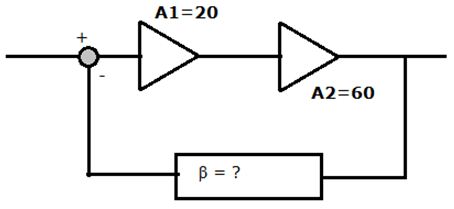
a) 0.41
b) 5
c) 0.0041
d) It can be any real number
View Answer
Explanation: AF = A/1+Aβ
A = A1 x A2 = 1200
Thus 1 + Aβ = 1200/200 = 6
Aβ = 5
β = 5/A = 0.0041.
Sanfoundry Global Education & Learning Series – Analog Circuits.
To practice all areas of Analog Circuits, here is complete set of 1000+ Multiple Choice Questions and Answers.
If you find a mistake in question / option / answer, kindly take a screenshot and email to [email protected]
- Check Electrical & Electronics Engineering Books
- Apply for Electrical Engineering Internship
- Practice Electrical Engineering MCQs
- Check Electrical Engineering Books
- Apply for Electrical & Electronics Engineering Internship
